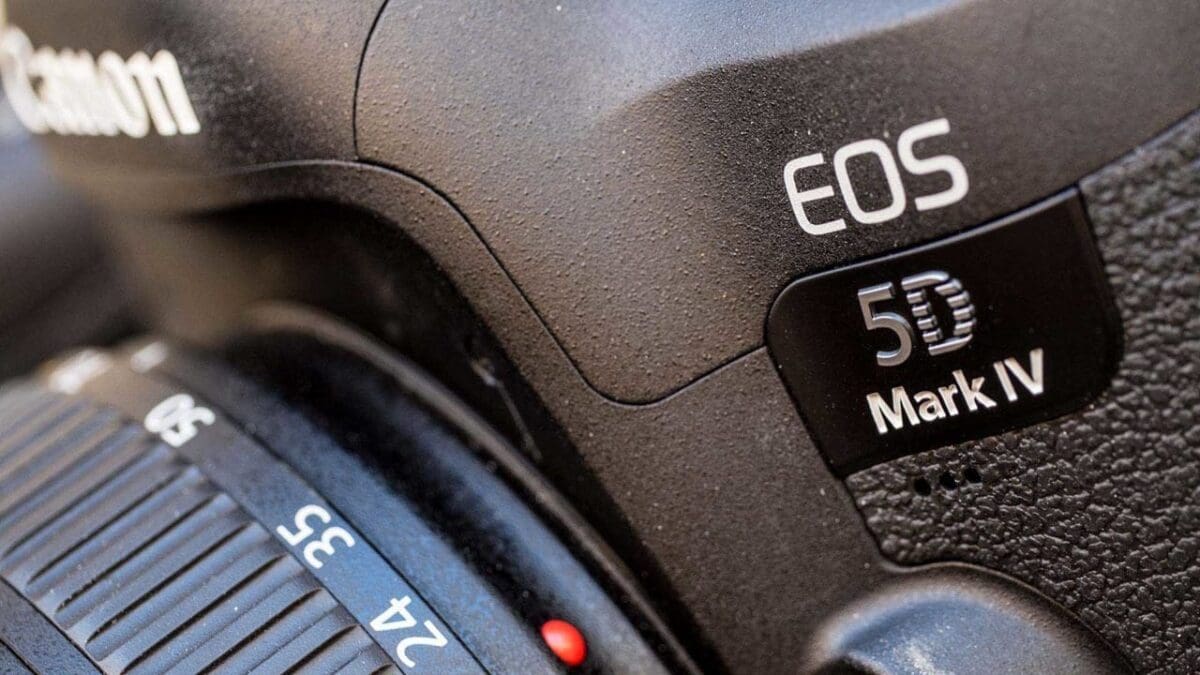Canon’s full-frame all-rounder gets a widely anticipated update with a few surprises. Find out how it performs in our Canon 5D Mark IV review.
30 second Canon 5D Mark IV review…
The 30Mp EOS 5D Mark IV is the latest in Canon’s 5D line of full-frame DSLRs, and the replacement for the 5D Mark III. It looks very similar to the camera it replaces, but there’s a new switch on the back to speed up some setting adjustments and the rear 3.2-inch 1,040,000-dot screen is touch-sensitive to enable more intuitive control. In addition, the 61-point AF system is more sensitive and therefore a little faster.
As well as enabling phase detection focusing in live view and video mode the Dual Pixel CMOS sensor facilitates a new raw feature that allows you to shift the sharp zone a little when processing images with the supplied Canon software. In practice it seems to be of limited benefit with real world images.
Image quality is high, with noise being controlled very well up to ISO 25,600. Video quality is also good, but the fact that the screen is fix rather than tilting or articulating seems a little out-dated and limiting. There’s also no Log mode to record flatter footage for grading, nor focus peaking or a zebra display option.
It’s an excellent all-rounder for shooting stills but some videographers maybe frustrated by the missing features.
Get the Canon 5D Mark III for £1300
Get the Canon 5D Mark III for $1700
Key features
Camera Name – Canon EOS 5D Mark IV
Camera type – DSLR
Date announced – 25th August 2016
Price at launch – £3,599/$3,499
Sensor size Full-frame – (36 x 24 mm)
Effective pixel count – 30.4 million
Processor – Digic 6 and Digic 6+
Lens/Mount – EF
Viewfinder – Optical with pentaprism 100% coverage
Sensitivity range – ISO 100-32,000 expandable to ISO 50-102,400
Reflex AF system – 61-point with 41 cross type including 5 dual cross type at f/8 and 21 cross-type at f/8
Live View AF system – Dual Pixel CMOS AF (Face Detection and Tracking AF, FlexiZone – Single, FlexiZone – Multi), available with all EF lenses and Touch shutter
Monitor – 3.2-inch Clear View LCD II with 1,620,000 dots
Max shooting rate – 7fps for 21 raw files or unlimited jpegs, 4.3fps in live view mode with AF tracking
Max video resolution – 4K (4096 x 2160)
Storage – CompactFlash (UDMA 7) and SD/SDHC/SDXC (UHS-1)
Dimensions – 150.7 x 116.4 x 75.9mm
Weight – 890g (body only)
In 2005 the Canon 5D was the camera that put full-frame digital photography within reach of enthusiast photographers. In 2008 the Canon 5D Mark II improved low-light performance and introduced Full HD movie recording to the mix, with the latter proving incredibly popular.
Then in March 2012, we saw the introduction of the Canon 5D Mark III, which brought a much needed improvement to the autofocus system. After a gap of around four and half years, Canon announced the 5D Mark IV (or Canon ESO 5D Mark IV to give its full name). It joins a marketplace that is seeing a rise in the popularity of mirrorless cameras and connected devices and brings a host of attractive upgrade on the Mark III model.
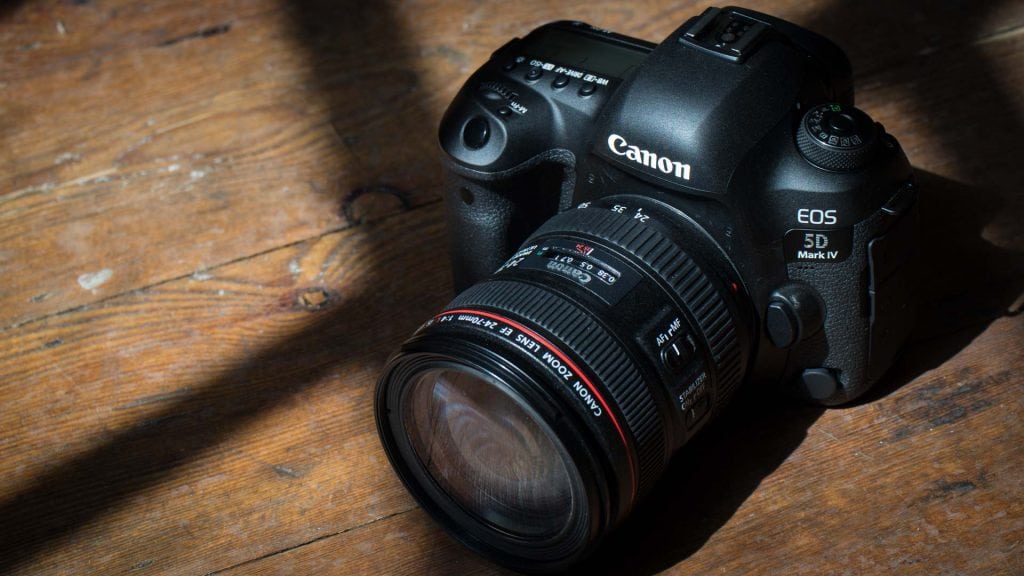
While the 5D Mark III has 22.3 million effective pixels, the Mark IV has 30.4 million, that’s a significant jump. However, the inclusion of Digic 6+ processing technology has enabled Canon to push the Mark IV’s native sensitivity range up from ISO 100-25,600 to ISO 100-32,000 with expansion settings taking this to ISO 50-102,400 – the same as the 5D Mark III. In video mode sensitivity can be set in the range ISO 100-102,400.
Interestingly, the Canon EOS 5D IV has a dual processor, as the Digic 6+ unit is accompanied by a Digic 6 processor. The Digic 6 processor takes care of the exposure metering while the Digic 6+ engine takes care of image capture and processing.
It enables a maximum continuous shooting rate of 7fps (frames per second) with continuous autofocus and metering for up to 21 raw files or an unlimited number of jpegs. In live view mode the camera can shoot at up to 4.3fps.
SEE MORE: Understanding camera sensor size in photography
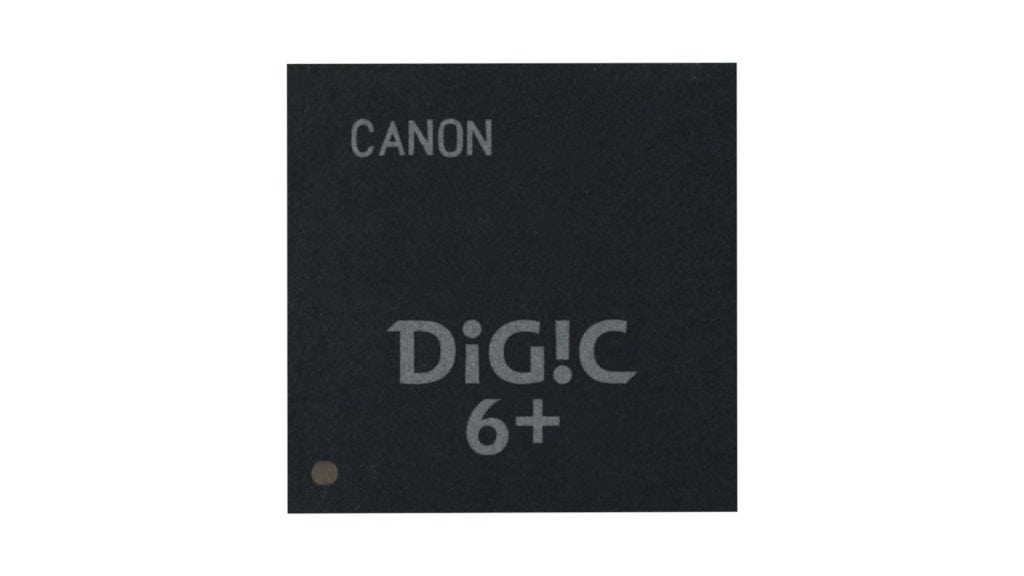
Canon hasn’t given the 5D Mark IV more autofocus points than the 5D Mark III but the 61 points are spread further up and down the frame. Also as before, there are 41 cross-type points, however, 21 of them are cross type down to f/8 (rather than f/4).
There are also 5 dual cross-type points that are sensitive down to f/8 (with the 5D Mark III these are dual cross-type at f/2.8). The system also operates down to -3EV, 1EV darker conditions than the 5D Mark III’s system. This all adds up to make the Canon 5D Mark IV’s autofocus system more sensitive and better able to detect a subject.
SEE MORE: DSLR cameras explained: 10 things to know about single lens reflex
Canon EOS 5D Mark IV Dual Pixel Raw
As with the Canon 80D and Canon 1Dx Mark II, the 5D MK IV’s sensor is a Dual Pixel CMOS device. This means that each of its pixels has two photo diodes that can be used to enable phase detection focusing in live view and video mode.
However, the 5D Mark IV adds another neat trick, Dual Pixel Raw. When this mode is activated via the menu, thanks to the slight off-set of each diode from its partner, it’s possible to make three types of unusual adjustment to the image post-capture using the supplied Digital Photo Professional (DPP) software.
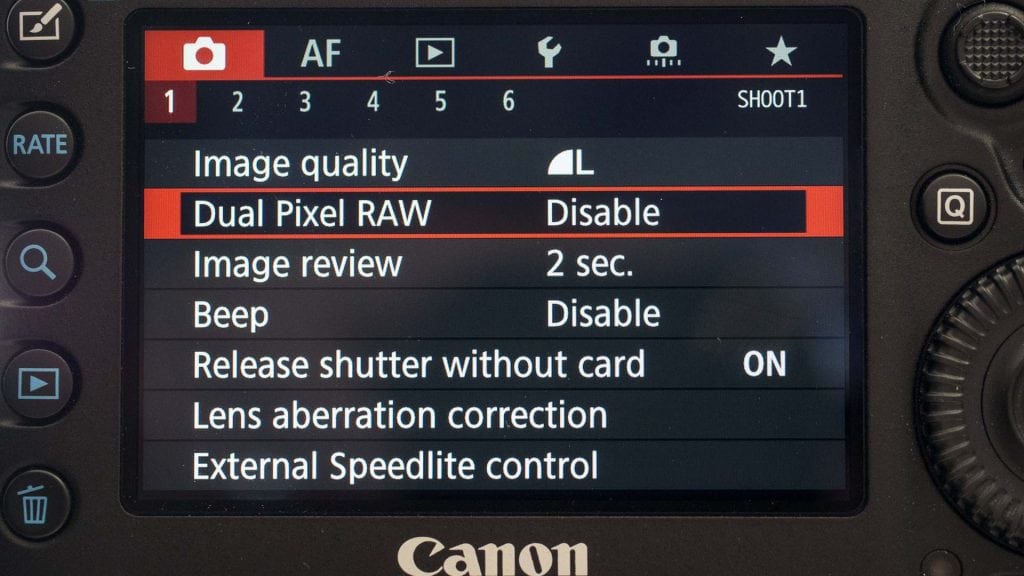
Image Microadjustment allows the position of maximum sharpness to be adjusted. Canon is careful to avoid using the word focus as its the sensor that is performing the trickery rather than the optics, but the effect is that the sharpest point of the subject can be shifted to correct for slightly missed focus – for example if the eyebrows of a portrait are sharp rather than the eyes themselves.
Bokeh Shift enables out-of-focus highlights to be moved along the horizontal plane so that they work better with the sharpest areas. Meanwhile Ghosting Reduction can help reduce the impact of artefacts such as flare.
Using Dual Pixel Raw rules out using some shooting modes and its not possible to shoot at 7fps. It also increase file size from around 35MB to 60MB. Read more about the Canon Dual Pixel Raw mode.
SEE MORE: What is a mirrorless camera: key technology explained
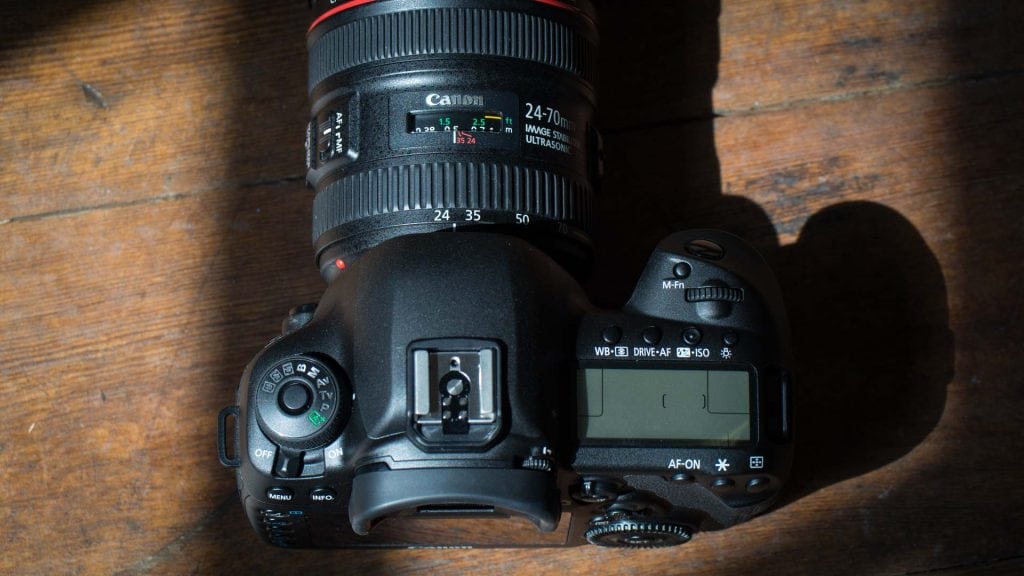
Canon EOS 5D Mark IV Exposure
The 5D Mark III is a great camera in many ways but its Evaluative metering system can be very frustrating because of the weighting applied to the brightness of the subject under the active AF point. In some instances this can be a blessing, but in others it can lead to significant under or over exposure of the image as a whole.
The Canon 5DS and 5DS R, however, have a 150,000-pixel RGB+IR metering sensor and the 252-zone metering system copes better with high contrast conditions. The 5D Mark IV has a similar system although the metering sensor has 153,000-pixels and there are 315-zones, and this should ensure better exposure balance in Evaluative metering mode.
Canon introduced flicker detection with the Canon 7D Mark II and this has now been upgraded and introduced to the 5D Mark IV. It’s designed to ensure correct exposure when shooting in fluorescent lighting that flickers and could potentially cause problems.
Canon EOS 5D Mark IV Video
Canon’s 5D Mark II and Mark II cameras have played an important role in the evolution of video shooting and the Mark IV continues this development by adding 4K recording capability. Like the Canon 1DX Mark II, but unlike many other cameras, we’re talking ‘true’ 4K (4096 x 2160) video at 30fps and in 4:2:2 (8 bit) here.
However, this is for internal recording only. It’s also possible to shoot Full HD video at up to 60fps and 720p video at 120fps, widening the scope for slow motion playback. Full HD footage can be recorded externally via HDMI.
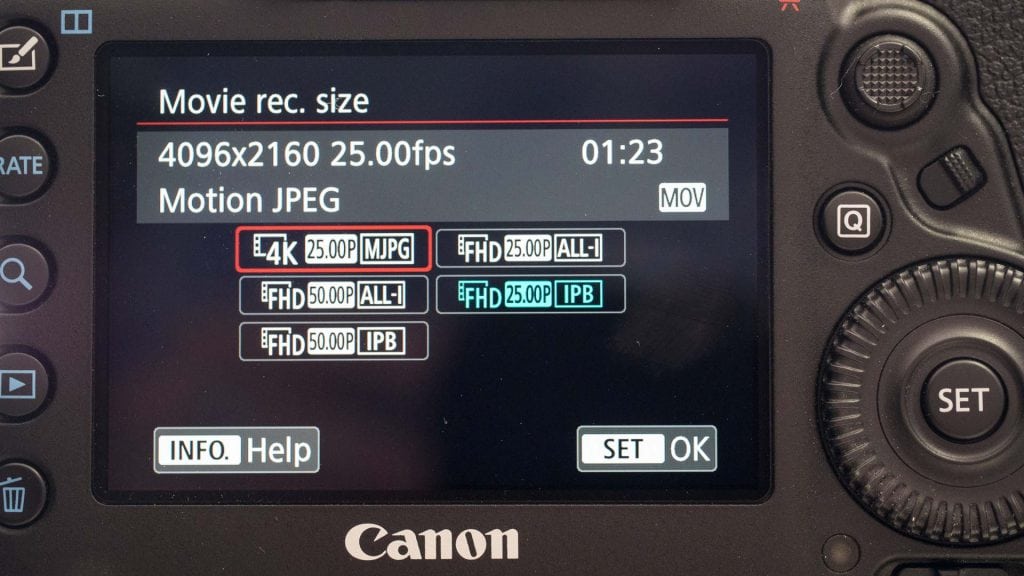
Disappointingly, there’s no video-specific Picture Style to produce flat footage that designed for grading. Instead, users must choose between Auto, Standard, Portrait, Landscape, Fine Detail, Neutral, Faithful or Monochrome. Alternatively, it’s possible to create three custom styles and there’s an HDR movie setting.
SEE MORE: How to set up a DSLR or CSC once you take it out of the box
Canon EOS 5D Mark IV Touch control
While Canon has stuck with the same screen size as the 5D Mark III for the 5D Mark IV, the 3.2-inch unit has 1,620,000 dots rather than 1,040,000. More significant, however, is the fact that the screen is touch-sensitive and it can be used for everything from setting AF point and tripping the shutter to navigating the menu and making setting selections. This is a great move that really speeds up operating the camera, making it more intuitive to use.
One disappointment, however, is that Canon has stuck with a fixed screen. A tilting or vari-angle screen would’ve been nice, especially bearing in mode the potential video usage of the camera. It would feel more natural to tap on a screen that’s tilted to face you.
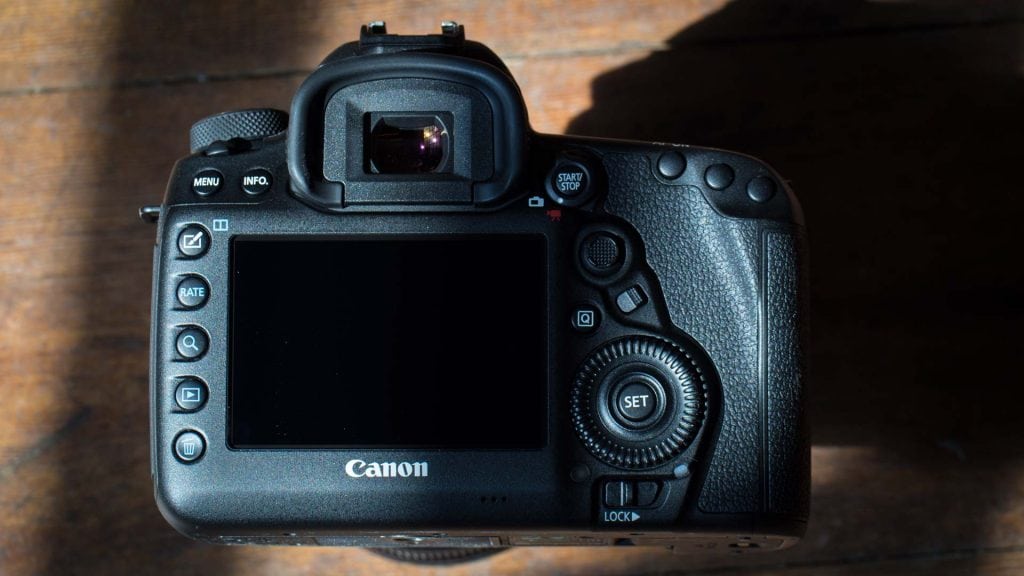
Canon EOS 5D Mark IV Connectivity
Canon got on-board with Wi-Fi connectivity pretty quickly but this is the first time a high-end Canon DSLR has featured Wi-Fi connectivity. In addition, secure file transfer (FTPS/FTP) is possible via a smart device using the new Canon Camera Connect app. And for the first time IPTC metadata such as the details of a shoot can be input and embedded automatically into files.
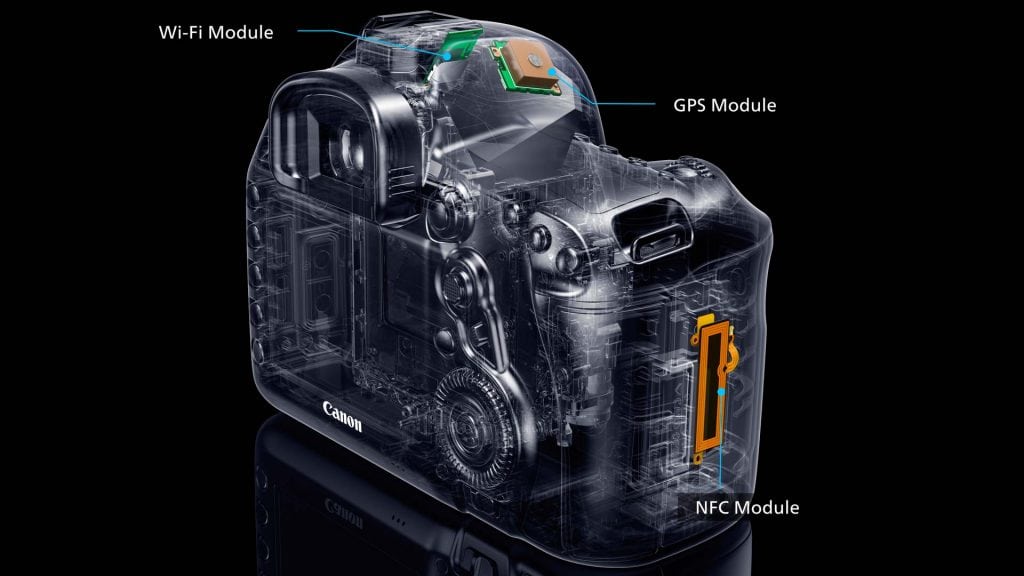
An NFC chip enables quick connections to be made and for the camera to be used with the Canon Connect Station CS 100.
There’s also a GPS chip that enables location information to be recorded. This has two operation modes; in Mode 1 the GPS signal continues to be received while the camera is turned off while in Mode 2, the GPS system is switched off when the camera is switched off. Mode 2 prevents the battery from becoming flat when the camera is not in use.
In addition to ports to connect an external microphone and headphones, the 5D Mark IV has mini-HDMI and USB 3.0 ports. The latter has resulted in the remote release port being moved to the front of the camera.
Canon EOS 5D Mark IV Storage and Power
Like the 5D Mark III, the 5D Mark IV has two card slots, one for CompactFlash (CF) and the other for SD/SDHC/SDXC type media. Both have been uprated and the CF card slot gets the speed benefits of UDMA 7 media while the SD port is now UHS-I compatible.
These upgrades will be welcome as will the news that the 5D IV can accept the same LP-E6 batteries as the Mark III and it’s supplied with an LP-E6N battery. This has claimed battery life of 900 shots.
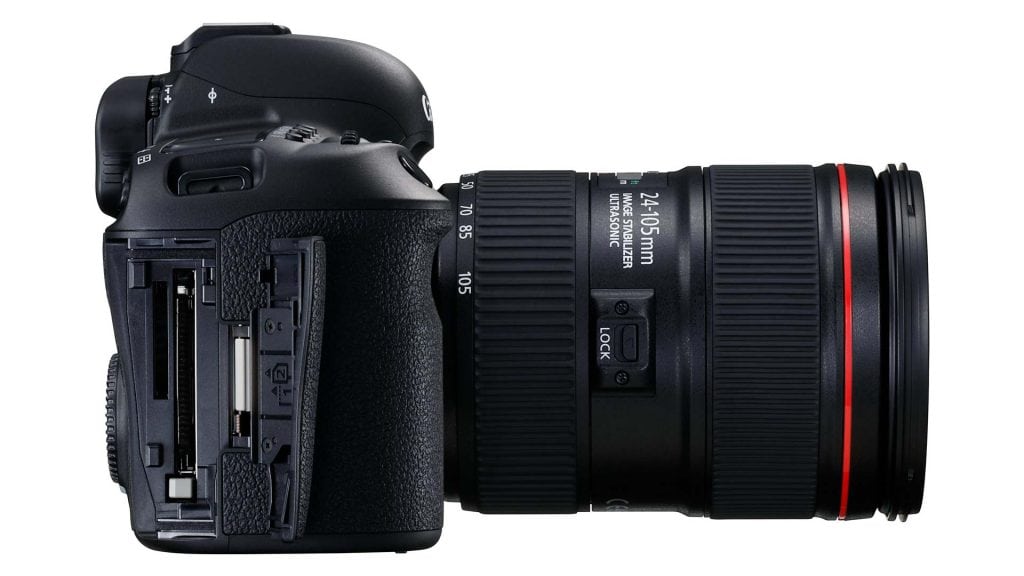
Canon EOS 5D Mark IV Build and Handling
As we had expected, Canon has kept the design of the 5D Mark IV very similar to that of the 5D Mark III, but there are a few small changes. The most noticeable of these is the arrival of a new customisable button on the back of the camera. This is used in a similar way to the lever on the back of the Canon 7D Mark II and it changes the purpose of the front main dial.
SEE MORE: Best cheap cameras that are actually pretty awesome
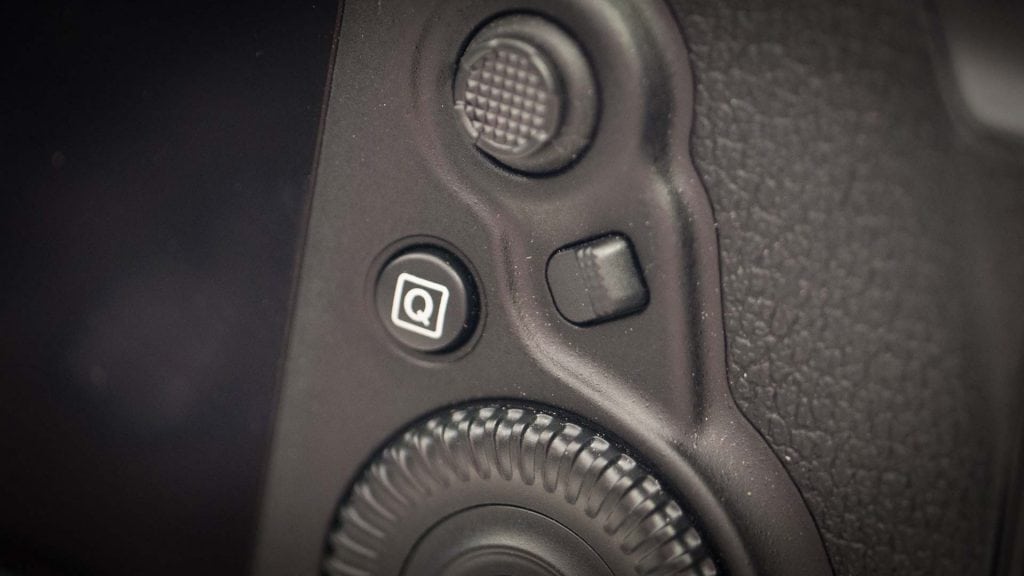
It’s not apparent when you’re holding the camera, but we’re told that the weather-proofing has been enhanced in comparison with the 5D Mark III, with the addition of grommets and seals to make it more durable.
In other slight changes from the 5D Mark III, the new camera’s finger-grip and the rear thumb rest are is slightly deeper. It doesn’t make a very noticeable difference, but in theory the 5D Mark IV should be a little more secure in your hand. I can’t say I noticed a huge difference, but the Mark IV is comfortable to hold during a long shoot.
The presence of the GPS chip has also resulted in the bulge of the viewfinder housing being a little more pronounced.
The new camera is also approximately 50g lighter than the model it replaces – despite the extra weather-proofing and additional features. To some extent this can be explained by a switch from stainless steel to aluminium for the construction – the camera feels just as tough as the 5D Mark III.
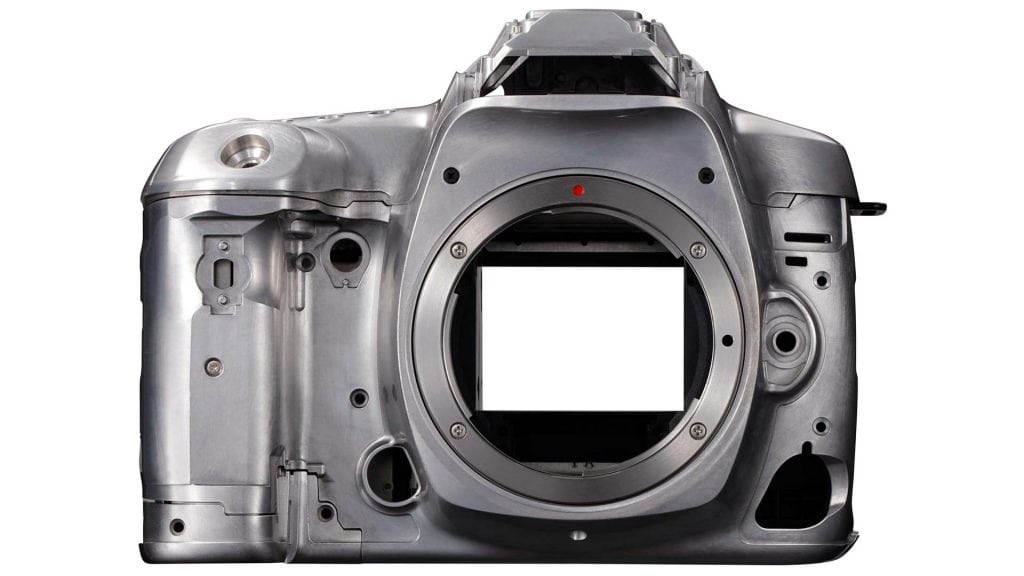
Canon has redesigned the 5D Mark IV’s mirror box and assembly to help reduce vibration and when you’re shooting at 7fps (frames per second) it feels a little smoother than the 5D Mark III at full-tilt (6fps).
On the back of the camera the new, higher-resolution screen is very good, making details nice and clear. I’ve used it in a range of conditions including bright sunshine and in the default settings I was still able to see the image reasonably well. The ability to tilt the screen, however, would make life much easier, especially when shooting video.
Canon EOS 5D Mark IV Performance
Jumping from 22.3 million pixels with the 5D Mark III to 30.4 million on the 5D Mark IV’s sensor enables the new camera to record more detail. There’s also been some development in camera technology during four year gap between the 5D Mark III going on sale and the 5D Mark IV’s arrival and consequently the 8Mp increase in pixel count doesn’t come with an increase in image noise – it’s the opposite in fact.
As usual, high ISO setting performance depends upon your subject and the shooting conditions. In the confines of a bike repair shop the 5D Mark IV produced very acceptable results at the maximum expansion setting (ISO 102,400), although with exposures of 1/200 sec, 1/400 sec and even 1/800 sec at f/8, the light-levels weren’t especially low and didn’t really demand such a high sensitivity setting.
When shooting buildings after dark, however, high sensitivity noise became more apparent in the even-toned sky, while some of the detail of the stonework was lost at ISO 32,000.
Overall the 5D Mark IV controls noise extremely well throughout its native sensitivity setting range (ISO 100-32,000). That said, while the results at ISO 32,000 are good, I feel happier using ISO 25,600 as the maximum. At ISO 32,000 the jpegs look a little mushier and the raw files a little grainier and the ISO 25,600 results have a bit more bite.
I use the Canon 5D Mark III on a regular basis as a comparison camera when I’m testing the autofocusing of other cameras. That’s not to say it’s the absolute best, it’s not, but it is very good. The 5D Mark IV’s reflex mode autofocusing is better, focusing a little quicker in low light conditions. It also does a good job of tracking moving subjects.
The Dual Pixel CMOS AF system that operates in live view and video mode is also very good and it’s capable of finding a moving subject and tracking it across the frame. Subjects that move quickly across the frame while moving towards or away from the the camera prove more problematic, but if it’s only the subject distance that’s changing and the active AF point is held over the subject, it does a good job of keeping them sharp. It’s certainly feasible to use the AF system when shooting video.
I used the Canon 5D Mark IV in evaluative metering mode for the majority of my testing and it performed well in many situations. There were a few situations, however, when I got better results when the exposure was reduced by 1/3EV. In most cases this was when there was a large dark area in the frame, or a few highlights that needed protecting. On the whole, however, it’s good, coping better with high contrast conditions than the 5D Mark III and being less heavily influenced by the brightness of the subject under the active AF point.
Colour-wise the 5D Mark IV produces the results I’ve come to expect from Canon. In the default Standard Picture Style, colours look pleasantly saturated and vibrant. And while the auto white balance setting does a good job, in daylight conditions (overcast or sunny) I generally prefer the results produced in Daylight mode.
I’ve examined lots of images taken using the 5D Mark IV’s Dual Pixel Raw mode and while it’s clear that the adjustments available in Digital Photo Professional’s Dual Pixel Raw Optimizer have an impact, it’s hard to see any real benefit to using it with real world images. Read Testing Canon 5D Mark IV Raw to find out more.
Like the stills from the 5D Mark IV, the videos also look great and provided the correct frame rates and shutter speeds are chosen, movement is recorded smoothly. The level of detail in 4K (4096 x 2160 pixel) movies is also good, but this resolution uses a relatively small (17:9 aspect ratio) area of the sensor so the impact of using wide-angle lenses is diminished.
SEE MORE: Best Canon EF-S lenses to start your collection
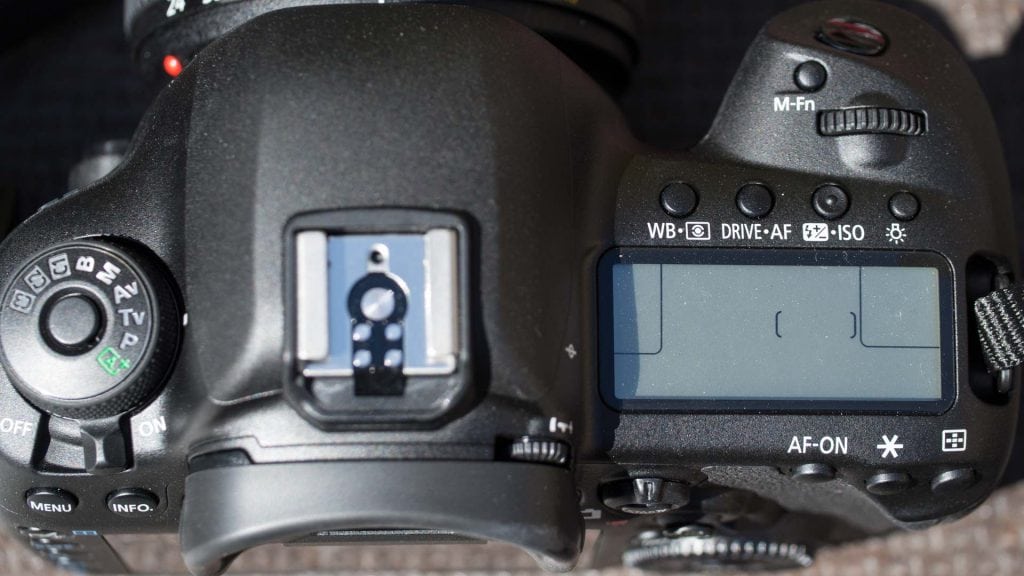
Canon EOS 5D Mark IV Verdict
The Canon 5D Mark IV is a worthy replacement for the Canon 5D Mark III. The step-up in pixel count makes perfect sense, raising it significantly above the 22Mp count of the 5D Mark III, but not competing with the 50Mp 5DS and 5DS R. In addition, the reflex AF system is more responsive and the live view and video focusing system is more reliable, making life easier for enthusiast videographers.
Further good news is that the metering system is improved over the 5D Mark III’s and noise is controlled well despite the increase in pixel count. It all adds up to enable high quality stills and video.
However, while I’m pleased with the introduction of a touch-screen and the degree of control that it affords, the fact that the screen is fixed is a disappointment. It’s a real drawback when you’re shooting video at anything other than eye-level. Some may argue that a vari-angle or tilting screen can be a weak point in a camera that is designed to be robust and weatherproof, but Ricoh has found a way with the Pentax K-1.
It is possible to use an external monitor with the 5D Mark IV and thus solve the issue of the fixed screen along with the lack of focus peaking and zebra display, but it means expense and, more significantly for some, extra weight and bulk. This could be enough to convince dedicated videographers to look at other models.
In summary, the 5D Mark IV is an excellent camera for enthusiast, pro and semi-pro photographers. It’s also a very capable video camera, but it’s possibly more suited for those who either only want to shoot video occasionally or those who want to build a rig around it.
[FAG id=9464]
READ MORE
Camera Rumours 2016
Best DSLRs in the world in 2016

